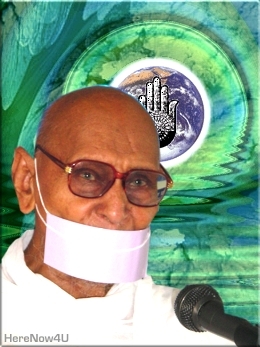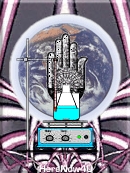
Is it possible to train people in non-violence? The question is neither unnatural nor irrelevant. It is a certain disposition of the mind which results in Ahimsa or non-violence.
The former can be the subject of training: not the latter. The same logic will apply to violence. A disposition can be got rid of as well as transformed. Its outcome can neither be removed nor transformed.
Origin of Violence
Man is given by instinct to acquisition and accumulation. It is here that violence is born. Transforming this instinct is the best means of bringing about non-violence. Training in non-violence lies solely in making efforts to rouse the awareness of non-acquisition.
We cannot even think of training in non-violence without a thorough discussion of and reflection on concepts like individual ownership, collective ownership, state ownership, cooperative ownership, centralized or decentralized economy. The tremendous attraction held out by individual ownership has been responsible for the success of the above system for economic development. Both collective and state ownership have beaten a retreat, as this is evident from the development of the past one decade, Cooperative ownership has fared no better, either, the reason is not far to seek. The instinct for ownership is at its strongest only at the level of the individual. In all other cases it gets enfeebled. This means there is a direct relation between acquisition and violence. The instinct for ownership leads to acquisition, which in turn breeds violence.
Training in Nonviolence: The Beginning
The solution to the problem of violence lies in answering the question: where does one begin for training people in non-violence? The first step to non-violence is fearlessness. Even a thousand repetitions of the Mantra, "Do not fear" will not rid an individual of fear so long as he is attracted by the body and infatuated by wealth and material objects. How can the aim be achieved by nursing the cause of fear in the mind and repeating the lesson of fearlessness orally? In what way can one block the flow of fear or about its rise? A proper and practical understanding of these issues is vital. Then only fearlessness can become the first stage of training in non-violence.
Seed of Non-Violence
Proprietorship, accumulation and fear are interrelated. It is not easily possible to get rid of them. However, they can be cleansed, refined and disciplined. Therein lies the seed of non-violence. The search for the means of refinements is difficult. Short-lived discipline or refinement is easy; making it lasting is very difficult. But, though difficult, it is not impossible.
First Practical Step
The course violence takes is from affection to thought and from thought to action. Therefore, the first step on the road to training in non-violence is sublimation and refinement of affections. The mind has to be trained to ensure that only positive, and no negative, affections are generated.
Formula for Physical Training
It comprises yogic postures, Asanas, and rhythmic control of breath, Pranayama: Padmasana, lotus posture, Shashankasana, moon posture, Yogmudra, sealing posture, Vajrasana, thunderbolt posture, Sarvangasan, all limbs posture, Matsyasana, fish posture, Godhikasana, posture adopted while milking a cow, etc. affect the nervous and the endocrine systems. Pranayama cools the systems and purges the body of the causative factors of violence, the physical factors responsible for violence are weakened.
Formula for Mental Training
The formula for mental training is meditation. Kayotsarga, total relaxation, Deerghashvas Preksha, perception of deep breathing or diaphragmatic breathing, Samvrittic Shvas Preksha, perception of exhalation and inhalation alternatively through the right and left nostril and similar meditational practices contribute to the development of concentration. Violence increases directly in proportion to the degree of distraction. So, diminishing distraction results in diminishing violence.
Formula for Affective Training
More important than physical and mental training is the training of affects. The formula for practising it consists in meditation on the Chaitanya Kendra, the centre of knowledge situated on the top of the head. It is one out of 13 psychic centres given importance in Preksha Meditation. Contemplative practices are useful for all the three types of training - physical, mental and affective.
Base and Field of Application
All these are methods of training the individual. In fact training in non-violence can be effective only at the level of the individual. Its application, of course, takes place at the level of society. It is, therefore, not inappropriate to say that the above training has the individual as its base and society as its field of application. The same holds good of violence. Accordingly, the most important way of bringing about a non-violent society is instructing individuals in non-violence. All training should be directed at this end.
Family Life and Nonviolence
Society implies interrelatedness of and interaction among individuals. Training in non-violence is required for achieving rectitude in behaviour and faithful human relationships. Its beginnings are best made in the family, for it is not proper to view violence as being limited to wars and terrorist activities. Wars take place only sometimes and in some places, whereas violence manifests itself within the family almost daily. It erodes mental peace, which in turn contributes to the spread of violence on a wide scale. Peaceful coexistence within the family is an important guarantee of the success of training in non-violence. Intolerance, lack of self-control and over-reaching ambitions poison the peace and happiness of a family. A curb on them and practice in avoiding them will automatically rid the family of the prevalence of violence.
Non-violence in the family means training in Anekant, the non-absolutistic view.
One major requirement for non-violence within the family is the spirit of reconciliation. It is possible to reconcile diverse thoughts and tastes. To achieve it, training in Anekant can be extremely useful, for Anekant admits coexistence in a relative sense and accepts autonomy only to the extent that such acceptance does not condone injustice. It approves of quality without disregarding unequal degrees of competence. The pillars of peace should be strong enough to withstand the strains of diversity. Training in Anekant gives due place to diversity, so long as it is not at the cost of unity. Making people aware of this coexistent duality, diversity and unity, will be an important step towards building a non-violent society.
Causative Factors of Violence in Society
There are innumerable social factors, some of them having come down to us since a long time past, that cause violence in society - casteism, racism, apartheid, regionalism and mass poverty, to name but a few. Time and time again they result in social conflagrations. Racism and discrimination based on colour can be tackled best by inculcating people with the spirit of common humanity. However, the problem of poverty is more complex. One aspect of the problem lies in the disparity between an inadequate supply of consumer goods and an ever increasing number of consumers. The problem gets compounded for the want of a proper and just sense of sharing. A high premium is placed on individual comfort and acquisition, while the desire to share things equally and justly is at a heavy discount.
The Basic Unity of Mankind
The basic unity of all people of the world should not be disregarded while considering the usefulness of the territorial integrity and independence of each nation. The instincts of self-aggrandizement and over ambition prove subversive to world unity. Of course, man has not yet developed enough to be able to practise equity and justice in his treatment of others. This keeps the regional and geographical divides in the world alive. Extirpation of geographical boundaries is not a prerequisite to the creation of a non-violent society. But it is imperative that these boundaries are not allowed to snap the tender threads of humanity.
TRAINING IN NONVIOLENCE: THE BASIC ELEMENT
The basic element of a training in non-violence is to connect the heart of people with their mind. The following factors are required to be part of the training to bring about a change of heart.
Factors causing violent effects
| 1 | Greed | Tendency to acquire |
| 2 | Fear | Manufacture and use of armaments |
| 3 | Hostility | Tendency to take revenge |
| 4 | Anger | Internecine quarrels |
| 5 | Egoism | Hatred and discrimination based on considerations of caste and colour |
| 6 | Cruelty | Exploitation and killing |
| 7 | Intolerance | Sectarian strife |
| 8 | Absolute (as opposed to the relative) thinking. | Obduracy and the tendency to disregard the views of others |
| 9 | Absolute behaviour | Tendency to practise non-cooperation in communal life |
These instincts turn people violent. Change of heart means overcoming these instincts and cultivating new refined habits instead.

Formulas of Mental Training
| | greed: | Training in freeing oneself from the infatuation for material objects and the body. |
| | fear: | Training in cultivating fearlessness and in strengthening the will not to manufacture or trade in armaments. |
| | hostility: | Training in cultivating friendship and in eschewing the tendency to take revenge |
| | anger: | Training in learning to forgive. |
| | egoism: | Training in practising humility, non-violent opposition and non-cooperation with injustice. |
 | cruelty: | Training in cultivating goodwill for other sects and the ability to put up with diverse views. |
The last two factors [8], [9], causing violence, can be countered by training people in relativism of thinking and behaviour.
Negative feelings are to be countered by training in feeling positively.
Stopping nonessential violence
Training in non-violence will have as one of its constituents making the people aware of the need to give up nonessential violence. Wastage of water, over mining, killing innocent creatures and people are examples of nonessential violence. It has made man cruel and has disturbed the balance of nature.
Physical health and non-violence
There is an intrinsic relation between physical health and non-violence. Damaged health generates violence. One of the factors responsible for people committing suicide is inadequate sugar in the blood. Likewise, disorders of liver and spleen also contribute to violent thoughts. Therefore, training in differential dietetics and in the science of healthy living is a vital component of training in non-violence.
Economic health and non-violence
Training in the following subjects is necessary for the economic health of an individual as well as society:
- Voluntary parting with wealth
- Nonacquisition
- Decentralization of the economy
- Economics and world peace
- Economics and healthy society
- Legitimate means of making money
- Just distribution of wealth
- Restraint in consumerism and limitation of wants
It need not be emphasized that physical, mental, emotional and economic health have all to contribute to the creation of a non-violent society.
They have, therefore, to be the bases of the training in non-violence.
The base and field of experimentation for the training in non-violence
The success of the methodology of training in non-violence depends on the development of an individual mentality irrevocably committed to non-violence.
This has to be practised in the following areas
- Individuals as members of family
- Individuals as social beings
- Individuals as citizens of a nation
- Individuals as citizens of the world.
Today people are ideologically and regionally different. But non-violence requires a unified and integrated personality.
In order to develop it, a multi dimensional programme of training is necessary. The thought of a non-violent society disregarding the individual is as illusory as that of a non-violent individual without a non-violent society. The two are relative to each other. This basic fact should not be ignored while thinking of training in non-violence.
 Acharya Mahaprajna
Acharya Mahaprajna
 Source:
Source: